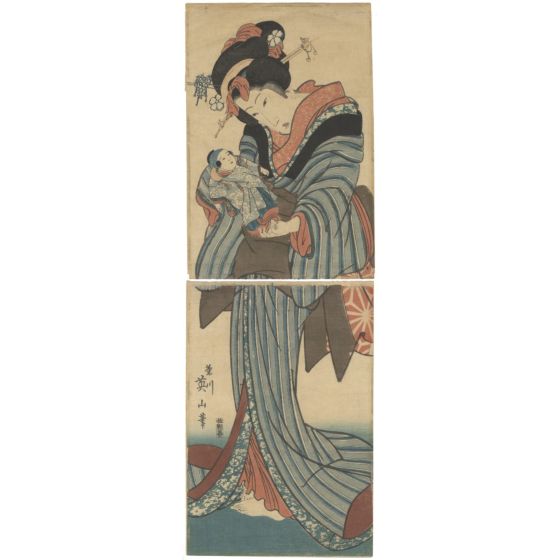Eizan Kikugawa, Beauty and a Doll, Kakemono-e
Artist: Eizan Kikugawa (1787-1867)
Title: Beauty and a Doll
Publisher: Sanoya Kihei
Date: Edo period
Dimensions: (T) 36.7 x 24.9 (B) 36.8 x 25 cm
Original Japanese woodblock print.
Kakemono-e is a format created from two oban-size sheets, one above the other in a vertical diptych, and its proportions resemble those of hanging scrolls (kakemono). Kakemono-e popular in the first half of 19th century mostly depict beautiful women (bijinga) or actor prints (yakusha-e).
In this print, a lady holds a beautifully dressed doll of a boy. Patterns of both of their garments create a compelling, eye-catching image. The woman leans forward, clearly interested in the doll, created so skilfully that it perfectly resembles a smiling baby.
Eizan Kikugawa
Within Japanese Art, Eizan Kikugawa is often referred to as one of the great masters of the beauty print genre, but this has not always been the case. He is believed to have started quite young, mostly creating beauty prints in Utamaro’s style in the beginning. Later in life, Eizan discovered his own style, while still showing the influence of Utamaro in the sensitivity, expressive sensuality and erotic charm of his work.
Eizan supposedly produced his first proper work in his teen years. It went on to be published, which was a rare accomplishment. It is also believed that he managed to become an accomplished artist by the age of 21. A particular artistic innovation, the scroll format, which is a vertical oban diptych that was popular in the late 1830s, is thought to have been invented by this artist.
The craft of woodblock printing lay in Eizan’s family. He was born as a son of Eiji Kikugawa who was a Kano-style painter. Studying with his father, and with Suzuki Nanrei later on, Eizan was also influenced by the works of Hokkei. The latter was an old friend of Eizan and the student of another master of ukiyo-e, Hokusai. Eizan himself had a few students, none of whom achieved the same heights of fame as their teacher, with the exception of Eisen. This is where the relationship of teacher and student became a little complicated: Eisen himself had a number of students collectively called Kikugawa school, but Eizan is regarded to be the school’s founder. The artist remained unmarried and childless and is believed to have been looked after by one of his students during his later years.
| Print Format | Kakemono-e (Scroll) |
|---|---|
| Artist | Eizan Kikugawa |
| Subject | Kabuki Theatre |
| Dimensions | (T) 36.7 x 24.9 (B) 36.8 x 25 cm |
| Condition Report | Backed, some ink spots on the top panel. |
| Publisher | Sanoya Kihei |
| Folders | In Store, FE |






